Women now make up almost half of the U.S. labor force, up from 38% in 1970. This nearly forty-year trend has been fueled by a broad public consensus about the changing role of women in society. A solid majority of Americans (75%) reject the idea that women should return to their traditional roles in society, and most believe that both husband and wife should contribute to the family income.
But in spite of these long-term changes in behaviors and attitudes, many women remain conflicted about the competing roles they play at work and at home. Working mothers in particular are ambivalent about whether full-time work is the best thing for them or their children; they feel the tug of family much more acutely than do working fathers. As a result, most working mothers find themselves in a situation that they say is less than ideal.
They’re also more likely than either at-home moms or working dads to feel as if there just isn’t enough time in the day. Four-in-ten say they always feel rushed, compared with a quarter of the other two groups. But despite these pressures and conflicts, working moms, overall, are as likely as at-home moms and working dads to say they’re happy with their lives.
Whether women work outside the home or not, family responsibilities have a clear impact on the key life choices they make. Roughly three-in-ten women who are not currently employed (27%) say family duties keep them from working. And family appears to be one of the key reasons that many do not break through the “glass ceiling” to the top ranks of management — that’s the view, anyway, of about a third of the public.
Working Mothers
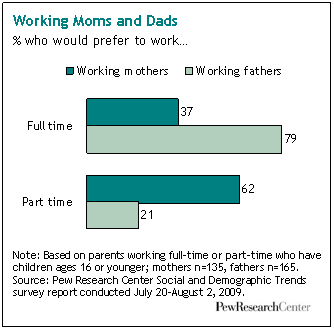
According to data collected by the U.S. Bureau of Labor Statistics, 59% of women now work or are actively seeking employment. An even higher percentage of women with children ages 17 or younger (66%) work either full or part time. Among those working mothers, most (74%) work full time while 26% work part time.
A survey taken this summer by the Pew Research Center’s Social & Demographic Trends Project asked working mothers whether they would prefer to work full time or part time. A strong majority of all working mothers (62%) say they would prefer to work part time. Only 37% of working moms would prefer to work full time. Working fathers have a much different perspective. An overwhelming majority (79%) say they prefer full-time work. Only one-in-five say they would choose part-time work.
These findings echo the results of a 2007 Pew Research Center survey in which a majority of working mothers (60%) said the ideal situation for them would be to work part time. This represented a significant increase from 10 years earlier when only 48% of working mothers had said the same.
Women’s Growing Presence in the Workforce
The percentage of women working or actively seeking employment grew steadily from the 1950s onward, peaking in 2000. As an overall share of the labor force, women today comprise 47%.1 The growth in the share of women in the workforce has leveled off in recent years, just as women’s participation rate stopped climbing. Nonetheless, the fact remains that women have transformed the American workplace over the past 50 years, and in so doing have created a series of conflicts and challenges for today’s working women that have proven to be difficult to resolve.
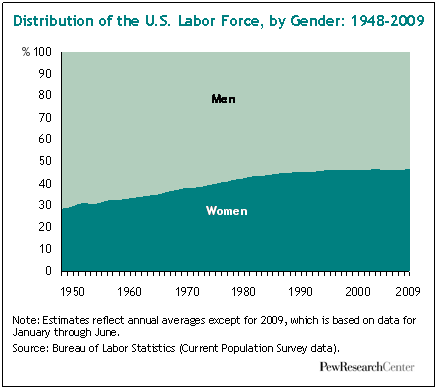
Public Views on the Changing Role of Women
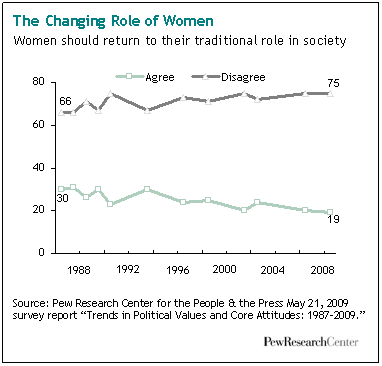
As women have taken a more active role in the labor force, public opinion has become increasingly supportive of this new reality. The Pew Research Center for the People & the Press has been tracking public attitudes on social and political values, including the changing role of women, for the past 20 years. In 1987, 30% of Americans said women should return to their traditional roles in society, while 66% disagreed with this statement. Today, only 19% agree that women should return to their traditional roles while 75% disagree.
Women and men are equally likely to reject the notion that women should return to their traditional roles. Young people are among the most progressive on this issue. Among those under age 30, 84% disagree with the idea that women should go back to a more traditional role.
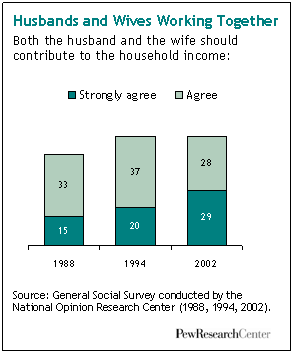
Further evidence of the changing attitudes about family and the role of women can be seen in another item included in the Pew Research Center’s values surveys. Seven-in-ten Americans (71%) agree with the statement “I have old-fashioned values about family and marriage.” While still a strong majority, this is down significantly from 87% who held this view in 1987. Again men and women are in agreement on this issue, and young people express the least conservative views: 61% of those under age 30 say they have old-fashioned values about family and marriage.
Looking more specifically at the question of women and the workplace, data from the General Social Survey shows how attitudes changed from the late 1980s to the turn of the century. When asked whether they agreed or disagreed that both the husband and the wife should contribute to the household income, the percent of Americans who strongly agreed grew steadily from 1988 to 2002. In 1988 only 15% strongly agreed that both spouses should contribute to the household income, by 2002 29% strongly agreed (another 28% agreed but not strongly).
Even as society has become more accepting of women’s role in the workforce, attitudes about a special class of female workers — namely mothers of young children — have changed very little. In 1994 and again in 2002 the General Social Survey asked whether women should work outside the home under certain circumstances. In both years, strong majorities said a woman who is married but has not yet had children should work full time.
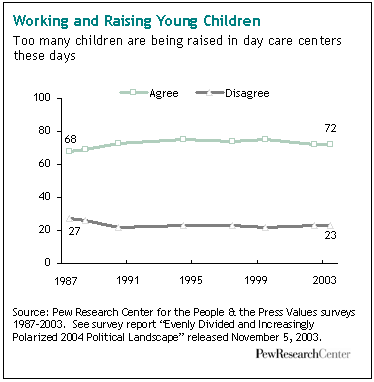
However, only 10% in 1994 and 11% in 2002 said a woman with a young child should work full time. Respondents were more accepting of full-time work for a woman whose youngest child had started school. However, even then pluralities in 1994 and 2002 said part-time work would be preferable under those circumstances.
Pew Research Center data shows that strong concern over the impact of day care on the nation’s children has persisted over time. In 1987, 68% of the public agreed that too many children are being raised in day care centers these days. In 2003, 72% agreed with this statement.
Mothers themselves are particularly concerned about this issue. In the 2003 Pew Research Center survey 50% of mothers with children under age 5 completely agreed that too many children are being raised in day care centers today. This compared with 36% among the general public.
The Challenges of Today’s Reality
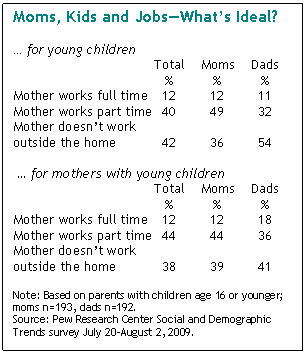
Herein lies the dilemma: women are a permanent part of the workforce, society has endorsed this historic change, but public opinion hasn’t yet fully come to terms with the tradeoffs inherent in working and raising young children. Large majorities of Americans believe that the ideal situation for both mother and child is that a mother with young children does not hold a full-time job. Only 12% of the public says what’s best for a young child is that their mother works full time. Four-in-ten say the ideal situation for a young child is a mother who works part time, and 42% say what’s best is if the mother doesn’t work at all.
When it comes to what’s best for the mother, the results are strikingly similar: 12% say the ideal situation for mothers with young children is to work full time, 44% say part-time work is ideal and 38% say it’s best if the mother doesn’t work at all. In perhaps the most powerful evidence of the cross-pressures that many working mothers feel every day, only 13% of moms who work full time say having a mother who works full time is the ideal situation for a young child.
Men and women agree that a full-time working mother is not what’s best for a young child. However, while most dads (54%) say the ideal situation for a child is to have a mom who doesn’t work at all, a plurality of moms (49%) say having a mom who works part time is what would benefit a child most.
Why Some Women Don’t Work?
Roughly four-in-ten women, including 34% of women with children age 17 or younger, do not work outside the home. According to a 2007 Pew Research Center survey, these at-home moms are slightly younger, on average, than moms who work full or part time. They have less formal education and lower household incomes than working mothers. Only 21% of at-home moms are college graduates, compared with 34% of working moms. And, while 37% of at-home moms report an annual household income of less than $30,000, only 20% of working moms fall into this income category.2
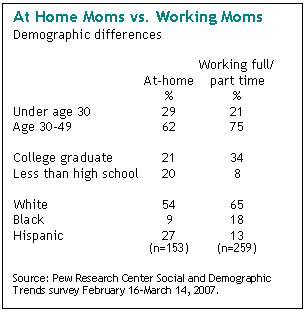
In addition, at-home moms are more likely than working moms to be Hispanic. In the 2007 survey, 27% of the at-home moms surveyed were Hispanic. This compares with 13% of working moms. African American women are more heavily concentrated among working mothers: 18% of mothers who work full or part time are black, while only 9% of those who don’t work are black.
When asked about the impact the rise in working mothers has had on society, at-home moms have a more critical view than do working moms. A plurality of at-home moms (44%) say the increase in working mothers with young children has been bad for society. Only 22% think this trend has been good for society, and 31% say it hasn’t made much difference. Working mothers are more evenly split on this question: 34% say the trend toward more mothers with young children working has been good for society, 34% say it has been bad for society and 31% say it hasn’t had much of an impact.
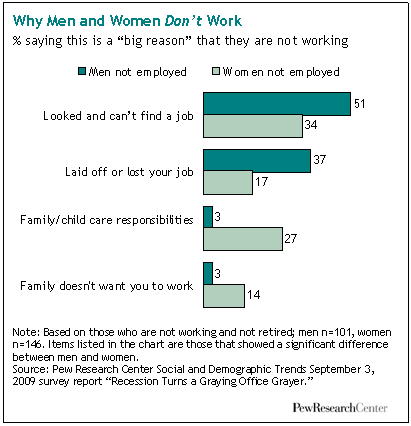
At-home moms and working moms also differ in their self-evaluations. When asked to rate the job they are doing as parents on a scale of 0 to 10 (with 10 being the highest), 43% of at-home moms give themselves either a 9 or a 10. Moms who work either full time or part time are harder on themselves — only 33% give themselves a 9 or 10.
The reasons women don’t work are somewhat different from the reasons men don’t work, and for women family is a much more important factor. Among those who are not working and not retired, the most important reasons men give for being unemployed are that they’ve looked and can’t find a job (51% say this is a “big reason”) or that they’ve been laid off or lost their job (37%).
Women who are not working and are not retired are less likely than men to say that being unable to find a job or losing a job are major reasons why they are not working. While 34% of women who are not employed say they are not working because they can’t find a job, more than a quarter (27%) say family or childcare responsibilities is a major reason why they are not working. Only 3% of men who are not employed say this is a major reason they are not working. In addition, women are more than four times as likely as men to say they are not working because their spouse or family doesn’t want them to work (14% vs. 3%).
The Glass Ceiling: Is Family a Factor?
A 2008 Pew Research Center survey explored the reasons why, in spite of their growing presence in the labor force, so few women have risen to the top ranks of American business and politics. Respondents were asked to evaluate a series of potential reasons why there are not more women in top level business positions and high political offices. With regard to business, what’s holding women back, according to the public, are the “old-boy network” and the fact that women haven’t had access to corporate America long enough to rise to the top. Many respondents also said that women’s family responsibilities don’t leave time for running a major corporation. Women themselves were somewhat more likely than men to say this is a major reason why so few top level business positions are held by women (37% vs. 32%).

When asked why there are not more women in high political offices, more than a quarter of the public (27%) said a major reason for this is that women’s responsibilities to family don’t leave time for politics. Other important reasons included that Americans simply aren’t ready to elect a woman to higher office (51% said this is a major reason), women who are active in party politics are held back by men (43%), and women are discriminated against in all areas of life including politics (38%). It’s worth noting that for both business and politics, very few people said that a lack of ability, toughness or experience were major reasons why more women haven’t gotten ahead in these fields.
The Day-to-Day Lives of Working Moms and Dads
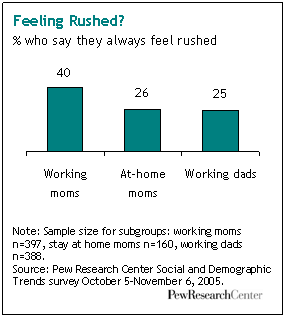
What sort of impact does working and raising a family have on the day-to-day lives of mothers? And do working fathers experience the same stresses and strains?
One thing is quite clear — working mothers feel rushed. In a 2005 Pew Research Center survey, respondents were asked how they felt about their time — did they always feel rushed, only sometimes feel rushed or almost never feel rushed. Overall, 24% of the public said they always feel rushed. But working mothers’ lives are much more harried than the average American’s. Four-in-ten working mothers with children under age 18 said they always feel rushed, and another 52% said they sometimes feel rushed. By comparison, 26% of mothers who don’t work outside of the home said they always feel rushed as did 25% of working fathers. Whether mothers worked part time or full time didn’t make a difference: 41% of moms who work full time and 40% of those who work part time said they are constantly feeling rushed.
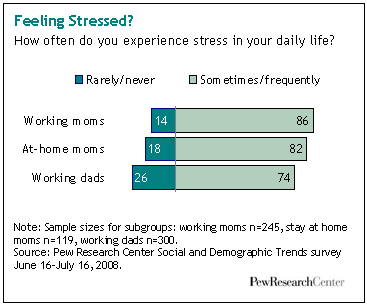
The 2008 Pew Research Center survey cited above included a question about the level of stress people experience in their daily lives. Relatively few Americans are immune from stress. Nearly three quarters say they experience stress sometimes (36%) or frequently (36%). Another 21% rarely experience stress and 5% say they never do. Women report experiencing somewhat more stress than men, and mothers have higher stress levels than fathers. For mothers, working outside the home does not seem to be correlated with stress. Mothers who stay at home are about as likely to say they frequently feel stressed as those who work full or part time. Working fathers are less likely than working mothers to feel stressed. In fact, 26% of fathers who work either full or part time and have children under age 18 say they rarely or never feel stressed. This compares with only 14% of working mothers.
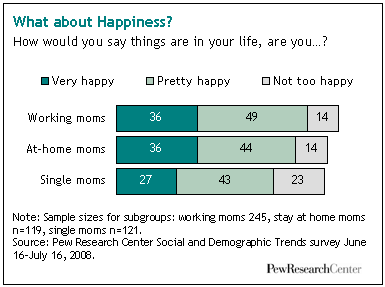
The good news for working moms is that, although their lives may be chaotic, they are just as happy overall as at-home moms and working dads. In the 2008 Pew Research Center survey, 36% of working moms said they were very happy with their lives. An equal proportion of at-home moms said they were very happy, and 38% of working dads said the same. Similarly, working moms are just as likely as moms who don’t work outside the home to say they are very satisfied with their family life (78% of working moms vs. 75% of at-home moms).
One group of women who are less happy and less satisfied with their family lives is single moms with children under age 18. Only 27% say they are very happy compared with 41% of married moms, and 63% are very satisfied with their family life vs. 85% of moms who are married.
Where Do We Go from Here?
Undoubtedly working mothers will continue to juggle their many responsibilities at work and at home. Most would prefer to work part time but the reality is that relatively few actually have the opportunity to do so. Furthermore, the demands of a tighter labor market may make it even more difficult for women to find jobs that allow for part-time work or flexible schedules.
Working fathers are also juggling more these days than they did in the past. As women have gone into the labor force in greater numbers, men have assumed more responsibilities at home. Research shows that married fathers now spend roughly twice as much time caring for children and doing housework as they did in the 1960s. Women are now spending less time on housework than they were in the 1960s, however they still bear much more of the burden for both housework and child care than do fathers.3
For their part, most fathers are content to work full time and few seem to feel conflicted over their competing roles at work and at home. Working women are left to wrestle with the competing demands of work and family.




